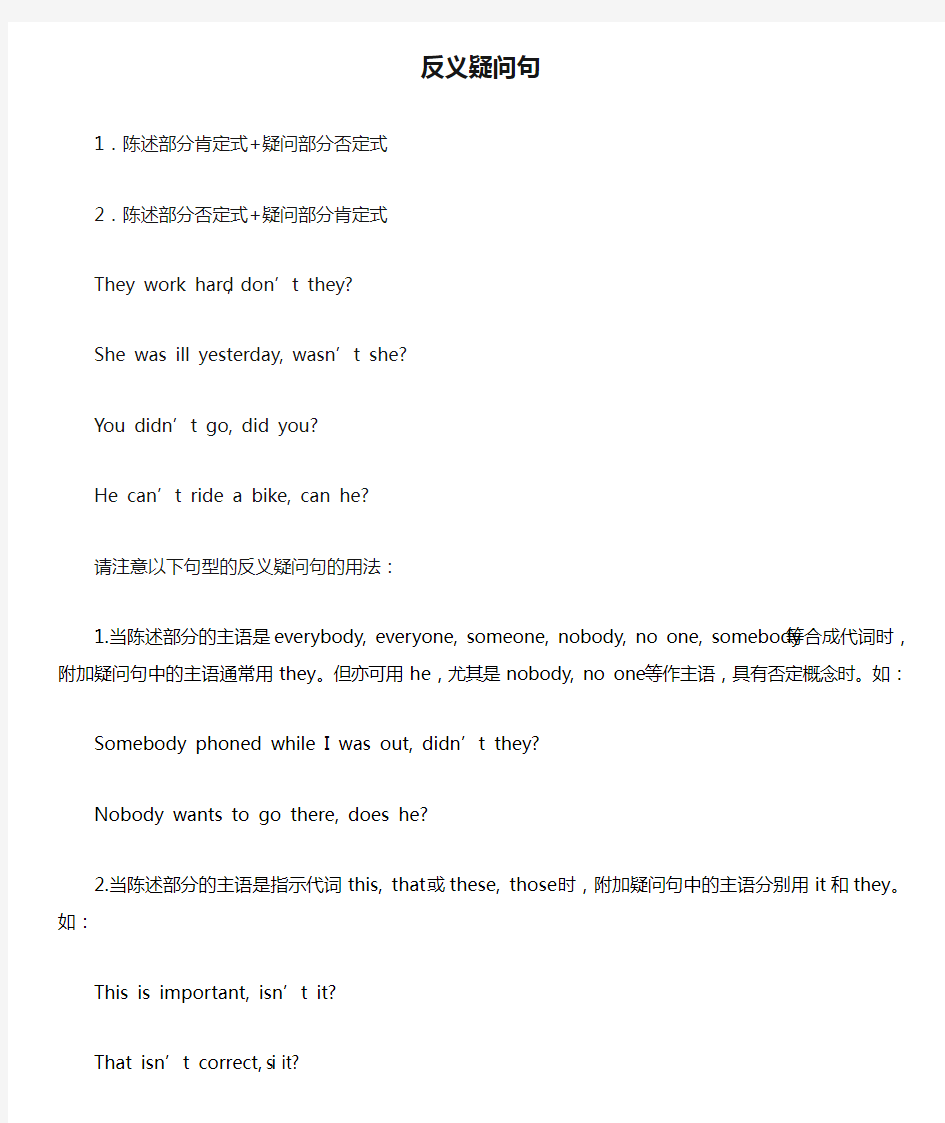
反义疑问句详解及练习和答案
- 格式:doc
- 大小:28.50 KB
- 文档页数:4


反义疑问句
1.陈述部分肯定式+疑问部分否定式
2.陈述部分否定式+疑问部分肯定式
They work hard, don’t they?
She was ill yesterday, wasn’t she?
You didn’t go, did you?
He can’t ride a bike, can he?
请注意以下句型的反义疑问句的用法:
1.当陈述部分的主语是everybody, everyone, someone, nobody, no one, somebody等合成代词时,附加疑问句中的主语通常用they。但亦可用he,尤其是nobody, no one等作主语,具有否定概念时。如:
Somebody phoned while I was out, didn’t they?
Nobody wants to go there, does he?
2.当陈述部分的主语是指示代词this, that或these, those时,附加疑问句中的主语分别用it 和they。如:
This is important, isn’t it?
That isn’t c orrect, is it?
These are your friends Tom and Jack, aren’t they?
3.如果陈述部分用I’m…结构,附加疑问部分一般用aren’t I。如:
I am strong and healthy , aren’t I。
4.当陈述句为there be结构时,附加疑问句中的主语也用there。如:
There’s no help for it, is there?
There’s something wrong, isn’t there?
5.陈述部分带有seldom, hardly, never, rarely, few, little, nowhere, nothing等否定词时,附加疑问部分的动词用肯定形式。如:Bob rarely got drunk, did he?
Few people know him, do they? She seldom goes to the cinema, does she?
如果陈述部分的否定词带有否定前缀,当作肯定,附加疑问部分一般仍用否定形式。如:He wa s unsuccessful, wasn’t he?
Tom dislikes the book, doesn’t he?
6.当陈述部分为主从复合句时,附加疑问部分一般应与主句的主语和谓语动词保持对应关系。如:
She says that I did it, doesn’t she?
I told them not everybody could do it ,didn’t I?
但当陈述部分的主语是I,谓语是think, believe, suppose, expect这类动词时,附加疑问部分则往往与从句中的主语和谓语动词保持对应关系,但要注意否定的转移。
I suppose that he’s serious isn’t he?
I don’t think she cares, does she?
7.在由“祈使句+附加疑问”构成的附加疑问句中,附加疑问部分一般用will you, won’t you, Don’t open the door, will you?
但是,以let’s开头的祈使句,附加疑问部分用shall we;以let us开头的祈使句,如果含义是allow us,不包括听话人在内,疑问部分用will you。如:
Let’s have a basketball match this afternoon, shall we?
Let us go out for a rest, will you?
8.当陈述部分带有情态动词must表示“必须”时,疑问部分用mustn’t。如:You must work hard next term, mustn’t you?
I must answer the letter, m ustn’t I?
但若表推测这层含义时,不能用must,而要根据陈述部分的不定式结构(即must之后的动词)以及含义采用相应的动词形式。如:
You must have made a mistake, haven’t you?
They must have seen the film last week, didn’t they?
He must be in the library, isn’t he?
9.当陈述部分含有情态动词used to时,疑问部分可用usedn’t或didn’t。如:The old man used to smoke, didn’t he?或usedn’t he?
Tom used to live here, usedn’t he?或didn’t he?
10.当陈述部分含有had better时,疑问部分用had。
如:You’d better finish your homework now, hadn’t you?
11.感叹句后的附加疑问句的谓语动词需用be的现在时,且常用否定形式。如:What a clever bo y, isn’t he?
What a lovely day, isn’t it?
12.陈述句子中的主语为动词不定式短语、动名词短语或其他短语时,疑问部分的主语通常用it。如:
Learning how to repair motors takes a long time, doesn’t it?
Between six and seven will suit you, won’t it?
Where to hold the meeting has not been decided, has it?